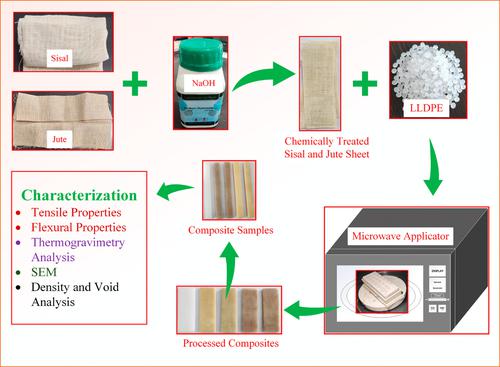当前位置:
X-MOL 学术
›
Polym. Compos.
›
论文详情
Our official English website, www.x-mol.net, welcomes your feedback! (Note: you will need to create a separate account there.)
Development and characterization of microwave‐processed linear low‐density polyethylene based sisal/jute hybrid laminates
Polymer Composites ( IF 5.2 ) Pub Date : 2024-03-26 , DOI: 10.1002/pc.28342 Hari Om Maurya 1 , Gaurav Kumar 2 , Lalta Prasad 1 , Pranjal Gupta 3
Development of hybrid laminates using microwave energy at 2.45 GHz. The mechanism of microwave‐based processing of polymer composites has been discussed. Effect of layering sequence on mechanical and thermal properties of the developed composite. Assessment of tensile strength with morphology, flexural strength and thermo‐gravimetric analysis.
中文翻译:

微波加工线性低密度聚乙烯剑麻/黄麻混合层压板的开发和表征
天然纤维增强复合材料因其可生物降解性和生态友好性而受到广泛欢迎。纤维改性和杂交已用于解决亲水性和纤维不均匀性等问题。然而,高效制造仍然是天然纤维增强聚合物复合材料的挑战。本研究探讨了由剑麻和黄麻纤维组成的混合层压材料的微波加工潜力。该层压板由线性低密度聚乙烯(LLDPE)作为基体,剑麻和黄麻作为增强材料,在特定的功率、时间、频率和负载下进行微波处理。开发了四种具有不同堆叠顺序的层压板:剑麻-剑麻-剑麻(SSS)、剑麻-黄麻-剑麻(SJS)、黄麻-剑麻-黄麻(JSJ)和黄麻-黄麻-黄麻(JJJ)。开发的复合材料显示约 3% 的空隙含量,其中 SJS 和 JSJ 复合材料的空隙含量分别最低和最高。在所有配置中,SJS 复合材料表现出最高的拉伸强度和弯曲强度,分别为 15.27 MPa 和 20.40 MPa,比纯 LLDPE 提高了 42% 和 85%。表层具有高强度纤维的混合复合材料表现出优异的机械性能。对断裂样本的显微镜检查表明,纤维拔出和纤维断裂是主要的失效机制。由于基体和纤维之间的分层导致的横向失效是主要的,抓地力和规格区域是常见的失效点。将剑麻和黄麻纤维增强材料掺入聚合物中不会显着改变所制造的复合材料的热稳定性。上述结果表明微波辅助加工是生产天然纤维增强杂化聚合物复合材料的一种有前景的方法。 使用 2.45 GHz 微波能量开发混合层压板。 讨论了聚合物复合材料的微波加工机理。 分层顺序对所开发复合材料的机械和热性能的影响。 通过形态、弯曲强度和热重分析评估拉伸强度。
更新日期:2024-03-26
Polymer Composites ( IF 5.2 ) Pub Date : 2024-03-26 , DOI: 10.1002/pc.28342 Hari Om Maurya 1 , Gaurav Kumar 2 , Lalta Prasad 1 , Pranjal Gupta 3
Affiliation

|
中文翻译:

微波加工线性低密度聚乙烯剑麻/黄麻混合层压板的开发和表征



























 京公网安备 11010802027423号
京公网安备 11010802027423号